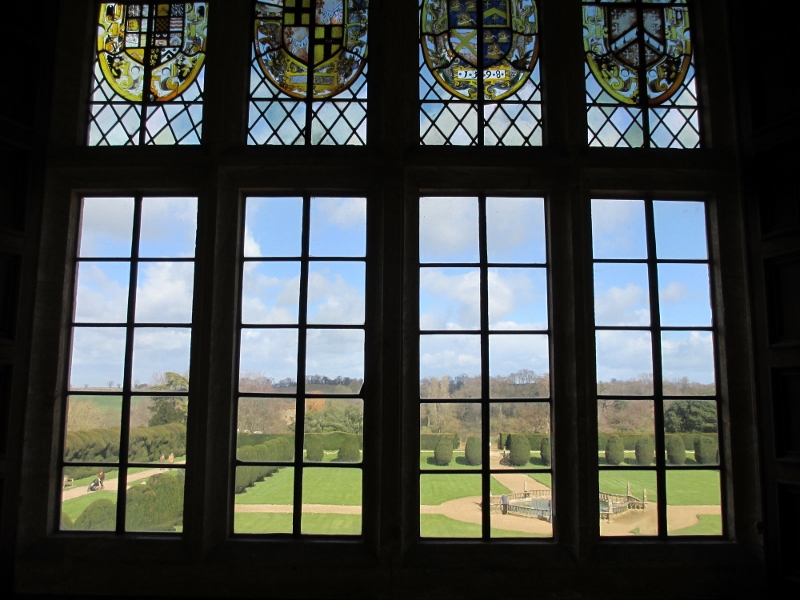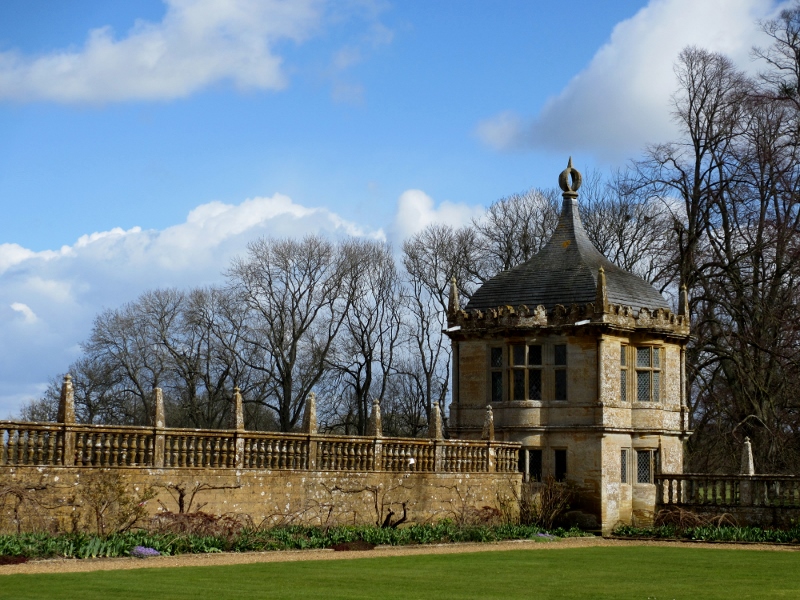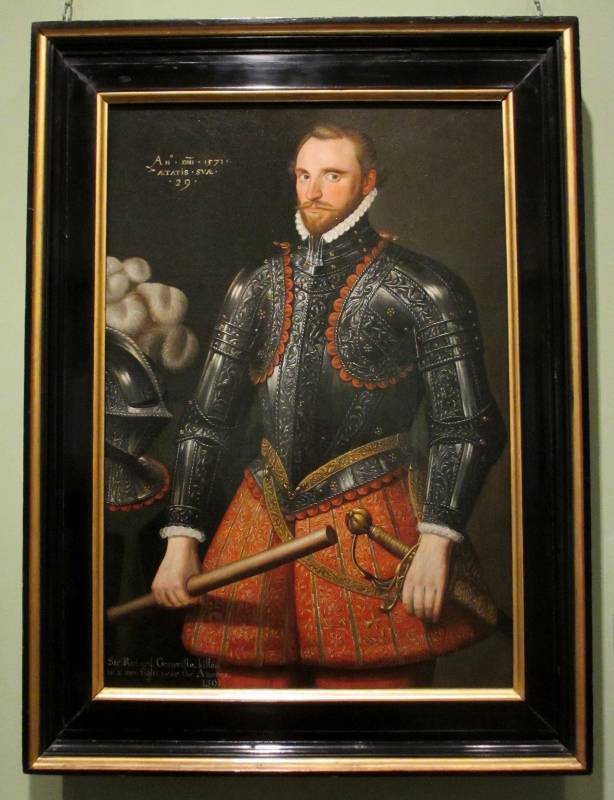Yesterday I was at Montacute, now very much home territory and a hitherto unexplored delight. One of the finest examples of Elizabethan Renaissance architecture in the country, with England’s largest surviving long gallery, spanning 172 feet between oriel windows, and some of the finest Elizabethan and Jacobean portraiture from the National Portrait Gallery – Montacute was a joy not least because here were some of the characters from the Roanoke mystery around whom the story of The Lost Duchess evolved. Standing before them was awe-inspiring.
This picture shows when the house was built: 1598. It was completed by Sir Edward Phelips, distinguished descendant of a Somerset family of yeoman stock, which rose to prominence during the Elizabethan and Jacobean eras, only to suffer catastrophic decline in the nineteenth century when William Phelips became insane and ended his days in an asylum after gambling away the family fortune and most of the Montacute estate.
The house presents a facade dominated by a multitude of glittering windows, a display of prodigious opulence at a time when glass was unaffordable for the majority of ordinary folk. The whole edifice is a window – a window on the Elizabethan golden age towards the end of the Queen’s glorious reign.
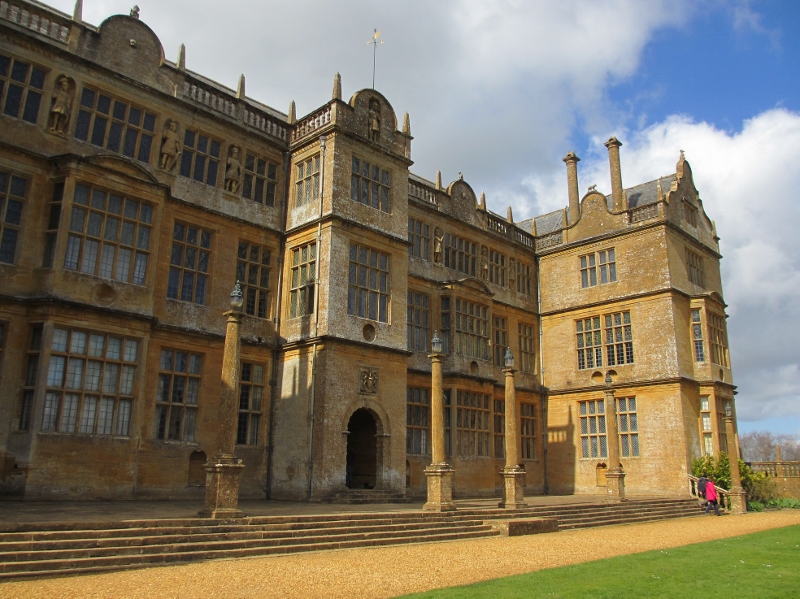
The frontage of Montacute showing some of the ‘Nine Worthies’ in niches on the top floor outside the Long Gallery
Within the house are many of Elizabeth I’s inner circle: Robert Dudley, Earl of Leicester, life-long favourite of the Queen, and his sister-in-law, Elizabeth Knollys, royal maid-of-honour early on in the reign. Not far from them are portraits of William Cecil, Baron Burghley, the Queen’s most trusted advisor, and Sir Edward Hoby, Secretary to the Council of War that prepared to confront the Spanish Armada. From the dashingly handsome Robert Carey, Earl of Monmouth, to a proud and resolute Sir Richard Grenville, brim full of daring-do and steely resolve, admiral of the fleet that took the first garrison to Roanoke; here is the flower of the spirit of the Elizabethan age.
Most poignant of all for me was the painting of Sir Walter Raleigh with his son, Wat, painted in 1602, some time after the ‘Lost Colony’ expedition of 1587 which he had backed and initiated. By the time of this later portrait, Raleigh’s attempts at colonising North America had failed, his hair has greyed and he is aged about 48, having lost his youthful good looks but still emanating confidence and poise. Not long afterwards, with the Queen’s death and the accession of James I, Raleigh fell from favour and was imprisoned in the Tower where he was to remain locked up for over twelve years. On his release to lead an expedition to Guyana, with the object of finding El Dorado along the Orinoco, Raleigh was an ailing elderly man of 62, doomed to fall victim to a trap in which both James I and Spanish agents were complicit. He was under oath not to attack Spanish possessions, yet confrontation was unavoidable. While he guarded the fleet at the mouth of the great river, his deputy, Lawrence Keymis, sailed upstream with Wat searching for the fabled gold mines. Defying orders, they attacked a Spanish outpost, and Wat was killed outright by a musketball while trying to prove himself in a reckless charge. Wat was no older than twenty-five and his father’s chief hope. Surrounded by Spanish forces and unable to hold the position, Keymis returned to beg for Raleigh’s forgiveness which Raleigh couldn’t bring himself to give; the hapless man then committed suicide. The Spanish demanded retribution, and Raleigh was beheaded as a traitor in 1616 leaving his youngest son, Carew, then aged 12 or 13, and Bess, his heartbroken wife.
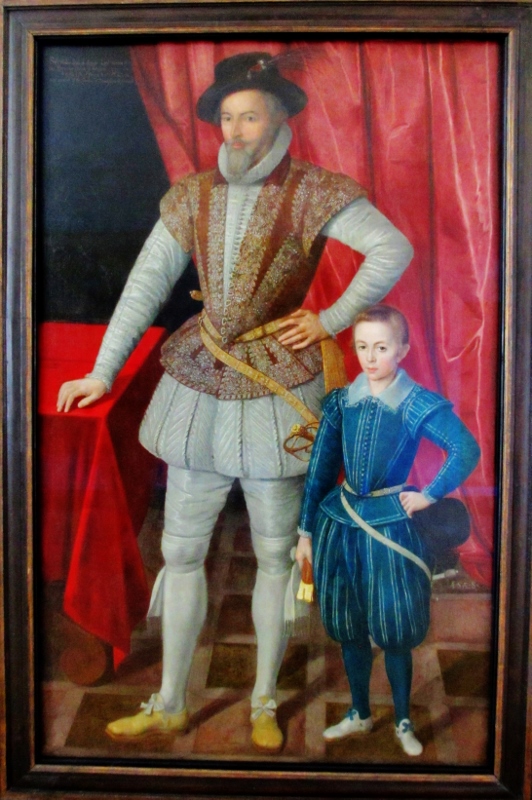
Sir Walter Raleigh and his son, Walter, known as ‘Wat’, painted in 1602 a year before the death of Elizabeth I
The letter written from the Tower by Raleigh to his wife and son on the eve of his execution is one of the most moving I have ever read. Here it is in full. Remember in reading this that Raleigh was one of the Queen’s great loves, though almost certainly their passion was never consummated, and he married Bess Throckmorton in secret which led to months of imprisonment in the Tower for both of them followed by years of disgrace. There is little doubt that Raleigh and Bess were deeply in love and remained devoted to one another.
Raleigh’s last letter to his wife and son:
You shall now receive (my deare wife) my last words in these last lines. My love I send you that you may keep it when I am dead, and my councell that you may remember it when I am no more.
I would not by my will present you with sorrowes (dear Besse) let them go to the grave with me and be buried in the dust.
And seeing that it is not Gods will that I should see you any more in this life, beare it patiently, and with a heart like thy selfe.
First, I send you all the thankes which my heart can conceive, or my words can rehearse for your many travailes, and care taken for me, which though they have not taken effect as you wished, yet my debt to you is not the lesse: but I pay it I never shall in this world.
Secondly, I beseech you for the love you beare me living, do not hide your selfe many dayes, but by your travailes seeke to helpe your miserable fortunes and the right of your poor childe. Thy mourning cannot availe me, I am but dust.
Thirdly, you shall understand, that my land was conveyed bona fide to my childe; the writings were drawne at midsumer was twelve months, my honest cosen Brett can testify so much, and Dolberry too, can remember somewhat therein. And I trust my blood will quench their malice that have cruelly murthered me: and that they will not seek also to kill thee and thine with extreme poverty.
To what friend to direct thee I know not, for all mine have left me in the true time of tryall. And I perceive that my death was determined from the first day. Most sorry I am God knowes that being thus surprised with death I can leave you in no better estate. God is my witnesse I meant you all my office of wines or all that I could have purchased by selling it, halfe of mystuffe, and all my jewels, but some one for the boy, but God hath prevented all my resolutions. That great God that ruleth all in all, but if you live free from want, care for no more, for the rest is but vanity. Love God, and begin betimes to repose your selfe upon him, have travailed and wearied your thoughts over all sorts of worldly cogitations, you shall but sit downe by sorrowe in the end.
Teach your son also to love and feare God while he is yet young, that the feare of God may grow with him, and then God will be a husband to you, and a father to him; a husband and a father which cannot be taken from you.
Baily oweth me 200 pounds, and Adrian Gilbert 600. In Jersey I also have much owing me besides. The arrearanges of the wines will pay my debts. And howsoever you do, solues sake, pay all poore men. When I am gone, no doubt you shall be sought for my many, for the world thinkes that I was very rich. But take heed of the pretences of men, and their affections, for they last not but in honest and worthy men, and no greater misery can befall you in this life, than to become a prey, and afterwards to be despised. I spoke not this (God knowes) to dissuade you from marriage, for it will be best for you, both in respect of the world and of God. As for me, I am no more yours, nor you mine, death hath cut us asunder: and God hath divided me from the world, and your from me.
Remember your poor childe for his father’s sake, who chose you, and loved you in his happiest times. Get those letters (if it be possible) which I write to the Lords, wherein I sued for my life: God is my witnesse it was for you and yours that I desired life, but it is true that I disdained my self for begging of it: for know it (my deare wife) that your son is the son of a true man, and one who in his owne respect despiseth death and all his misshapen & ugly formes.
I cannot write much, God he knows how hardly I steale time while others sleep, and it is also time that I should separate my thoughts from the world. Begg my dead body which living was denied thee; and either lay it at Sherburne (and if the land continue) or in Exeter-Church, by my Father and Mother; I can say no more, time and death call me away.
The everlasting God, powerfull, infinite, and omnipotent God, That Almighty God, who is goodnesse it selfe, the true life and true light keep thee and thine: have mercy on me, and teach me to forgive my persecutors and false accusers, and send us to meet in his glorious Kingdome. My deare wife farewell. Blesse my poore boy. Pray for me, and let my good God hold you both in his arms.
Written with the dying hand of sometimes thy Husband, but now alasse overthrowne.
Yours that was, but now not my own.
Walter Rawleigh
Bess is reputed to have had her husband’s head embalmed and kept it with her for the rest of her life.
Montacute gave me much to think about – a place to return to in quiet reflection. I’m sure before long I’ll go back…

